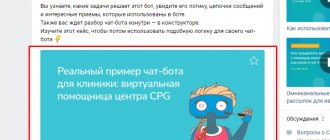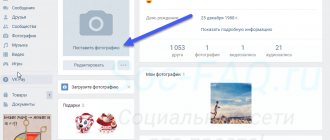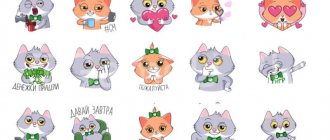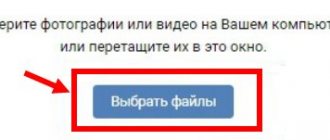Home » VKontakte » Image size for VKontakte post
0
merchant 09.08.2019 2307
The size of the image for a VKontakte post plays a huge role in the perception of content. Incorrectly selected parameters can significantly worsen the appearance of images: small images will stretch and lose clarity, and if the size is larger than the optimal size, compression will occur during loading, which will lead to a loss of quality. In some cases, inappropriate proportions can cause images to be cropped in the worst places.
The VKontakte social network has clear dimensions for pictures and photos in each individual section, so to get the desired image you just need to stick to them.
Image size for posts, entries in VK
Image size for posts, entries in VK:
- 3 to 2 – aspect ratio in length and width for a rectangular picture in a post on VK;
- 700 by 500 pixels – the optimal image size for posts/entries on VK;
- 1000 by 700 pixels – the maximum image size for an article;
- 510 by 510 pixels is the minimum size of a square image for a post on VKontakte.
Picture options in community sections
In order to properly design an avatar, cover, wiki page, products and other sections of the community in VK, you need to know the optimal image sizes for each of them. By adhering to the established framework, it is much easier to create high-quality professional design.
- Avatar
The recommended avatar size is 200x500 px, but it can be varied up to 7000 px, maintaining a 2:5 ratio. The thumbnail has a round shape with a diameter of 200 px.
- Cover
It is placed at the very top of the group above the avatar, moving it lower and is used to increase information content and further attract users - a prime example is the use of a live dynamic cover with automatically updated community statistics. Its recommended size is 795x200 px, but taking into account display on large screens, 1590x400 px will be optimal.
- Wiki page
To position an image across the entire width of the wiki page, the length of its bottom side must be at least 610 px. The height is set for each case separately, but maintaining the proportions of the source file is a mandatory requirement in any case.
- Goods
The size of product photos can be from 400 px to 7000 px, but the optimal option is considered to be 1000x1000 px. When creating a selection of products, images of 580x320 px are used.
- Photo status in the group
To display the status correctly, you must upload photos starting from the last one. Their most suitable size is 123x123 px.
What sizes to use in a group on VK
- An avatar for a group is one of the main images that a visitor pays attention to first. The avatar size starts from 200x500 pixels, and its thumbnail is 200x200 pixels. The miniature is selected by the community administrator himself when uploading an avatar. The display of the avatar may change depending on the presence of the cover, as well as on whether the user is viewing the group through the full version of the site or via mobile.
- The group cover is a relatively new phenomenon, with the advent of which community administrators have the opportunity to make their sites even brighter and more colorful. The recommended cover size is 1590x400 pixels. Like the avatar, the cover tends to change. The reason is the same - the way to view the community (the live cover in the VK group has different sizes).
- The size of images for posts is something that every group owner should know, since every day new posts are published in communities that cannot do without high-quality images. The minimum size is as follows: 510x510 pixels.
- Articles on VKontakte is another update that began functioning at the beginning of this year. It is recommended to select the cover size for the article as follows: 510x286 pixels, since this option is optimal.
- A snippet is a block that is automatically added when there is a link. If necessary, the image of this block can be changed, but it is better to do this based on the recommendations below. The recommended size is 537x240 pixels.
- The cover of a photo album is something that can highlight its theme with a specific image. The recommended size is 1200x800 pixels. Don't forget about those 200 pixels that are subtracted from the bottom of the image when viewing the album through the mobile version.
- The goods are just another new product. The recommended size is very easy to remember, because it is in the following numerical range - 1000x1000 pixels.
- Videos are an integral part of any social network. In order for subscribers to be able to watch videos in HD quality, the size must be at least 1280x720 pixels.
- Stories are an interesting thing that was also launched not so long ago. The recommended size for photos is 1080x1920 pixels, for video - 720x1280 pixels.
A well-designed community on VK is one of the factors that attracts users and forces them to become subscribers. Even if the page contains “million-dollar information,” it is unlikely that anyone will notice it if the group lacks design. Having spent just half an hour of your time studying this issue, things can go uphill the very next day. You just have to want it.
Guide to Image Sizes for Social Media in 2021
()
When creating content for social networks, it is very important to consider the recommended sizes for different types of images - posts, advertisements, profile headers or avatars. If you upload a picture of a smaller format, it will be stretched to the size set by the system, and a picture of a larger format will be cropped. This happens automatically and can result in a very sloppy or even incomprehensible image.
Keeping the exact dimensions of images for social networks in your head is not easy. An additional difficulty is that the requirements for graphics for social networks are constantly updated and new formats appear. It’s easy to keep track of updates on one or two social networks, but if you maintain pages on several platforms, you can get confused and use the wrong photo sizes.
Crello has prepared a list with current static image and video sizes for Facebook, Instagram, Twitter, Tumblr, Pinterest and YouTube. Save this table as a cheat sheet so you don’t have to look for the right parameters in social media guidelines every time you need to make graphics for Pinterest, pictures for your Twitter avatar, or headers for your Facebook page.
Let's divide the images into several categories. Let's start with the basic information: profile information:
Profile image: minimum 320 x 320 pixels
Post image: 1200 x 628 pixels (approx.)
Let's move on to cover sizes:
Profile cover: minimum 720 pixels in width
Static page cover: 820 x 312 pixels displayed
Page cover video: minimum 820 x 312 pixels, duration 20-90 seconds
Static event cover: recommended 1200 x 628 pixels
Event video cover: timing from 30 seconds to 5 minutes
Let's list the most popular Facebook advertising formats:
News Feed Advertising: 1.91:1 to 1:1, minimum 1080 x 1080 pixels
Advertising in Instant Articles: 9:16 to 16:9, resolution - the higher the better
Advertising in Instant Articles with a link: 1.91:1, minimum 1200 x 628 pixels
Advertising in Stories: 1080 x 1920 pixels
Carousel Ads: Minimum 1080 x 1080 pixels (recommended)
We've included the most popular formats in this list, but there are many different types of sponsored posts on Facebook. Please refer to the official Facebook Ads Guide for design specifications and technical requirements.
When working with Instagram, you need to focus on three main formats - profile image, feed post and story post:
Profile Image: 180 x 180 pixels (approx.)
Feed post image: 1.91:1 to 4:5, recommended width minimum 1080 pixels
Story: 1080 x 1920 pixels (approx.)
Instagram doesn't have profile covers or as many different formats for posts and ads as Facebook does. Here you need to focus on the following sizes:
Square in-feed advertising image: minimum 600 x 600 pixels, up to 1936 x 1936 pixels
Horizontal feed image: minimum 600 x 315 pixels, up to 1936 x 1936 pixels
Vertical advertising image: minimum 600 x 750 pixels, up to 1936 x 1936 pixels
Video ads: maximum size 4 GB
The Stories format is gaining popularity among advertisers. Now more than 400 million people scroll through stories every day, and brands are not missing out on the opportunity to take advantage of this. If you are also going to publish advertising in stories, follow the dimensions of this format:
Static story: 1:91 to 4:5, minimum 600 x 1067 pixels, recommended format 1080 x 1920 pixels in .JPG, .PNG, maximum size 30 MB
Video stories: 1:91 to 4:5, minimum 600 x 1067 pixels, recommended format 1080 x 1920 pixels in .MP4, .MOV, maximum size 4 GB, duration up to 15 seconds
The microblogging service uses only a few types of images. Here are the main sizes to focus on:
Profile Image: 400 by 400 pixels (approx.)
Profile header: 1500 by 500 pixels (approximately)
Post image: maximum size 5MB
Animated .GIF posts: maximum size 5 MB for mobile apps and up to 15 MB for website.
TUMBLR
If your brand has a Tumblr page, consider the following parameters:
Profile Image: 128 x 128 pixels (approx.)
Still images: 20 MB maximum size, displayed at 500 x 750 pixels standard and 1280 x 1920 pixels when enlarged
Animated posts in .GIF format: up to 540 pixels wide, maximum size 3 MB
Video posts: no more than 100 MB and 5 minutes per day in .MOV, .MP4 formats
Pinterest also doesn't offer much variety in terms of image formats. There are two main formats:
Profile Image: 165 x 165 pixels (approx.)
Pin image: minimum 600 pixels in width, ideally 735 x 1102 pixels
YOUTUBE
Here are the main image sizes for YouTube:
Profile image: 800 x 800 pixels (recommended), scaled down to 98 x 98 pixels; formats .JPG, .GIF, .BMP, .PNG (without .GIF)
Channel cover: minimum 2048 x 1152 pixels, 2560 x 1440 pixels (recommended), maximum size 6 MB
Preview: minimum 640 pixels in width, 1280 x 720 pixels (recommended); formats .JPG, .GIF, .BMP, .PNG, maximum size 2 MB
And finally.
Social networks are an excellent tool for promotion and sales. They regularly update algorithms and improve functions, becoming even more convenient. Requirements for user content, including images, are also changing. As a rule, radical changes do not occur, but if you do not check the recommended sizes for a long time, one day you will notice that the pictures in posts and on covers suddenly begin to display incorrectly. Most likely, this will be related to updates.
If you notice changes, refer to the social network's guidelines for the correct sizes. Or use online graphic editors like Crello - they make sure that the sizes of all formats are up to date and you don’t have to double-check them.
How useful is the publication?
Click on a star to rate!
Average rating / 5. Number of ratings:
No ratings yet. Be the first to rate.
SMM-toolsfreeinstagraminterestsocial networkstumblrtwitterfacebookyoutubetube
Conclusion
If you, like Fry, have not mastered everything in its entirety, then we have compiled a checklist that will help you select pictures for posts. Save and use:
- The best illustration is one that directly supports the text.
- For abstract topics - metaphors from the “second shelf”.
- Own illustrations are better, even if drawn with the left heel.
- Images from stock photos are the killer of good texts.
- Illustrations in an article without a caption are meaningless decoration.
- Find out the indirect interests of the audience before compiling a selection of pictures (don’t be fooled by stereotypes, what if your target audience fiercely hates cats and Bambi the deer?).
- Collections should support the same theme and color scheme.
- Don’t ignore the proportions of the pictures and frame them correctly (uneven selections won’t catch your attention, and your work will be in vain).
- Check the selection before publishing.
- Tenth point for good measure.
tonkoe-iskusstvo-podbora-kartinok-dlya-postov-v-sotssetyakh










